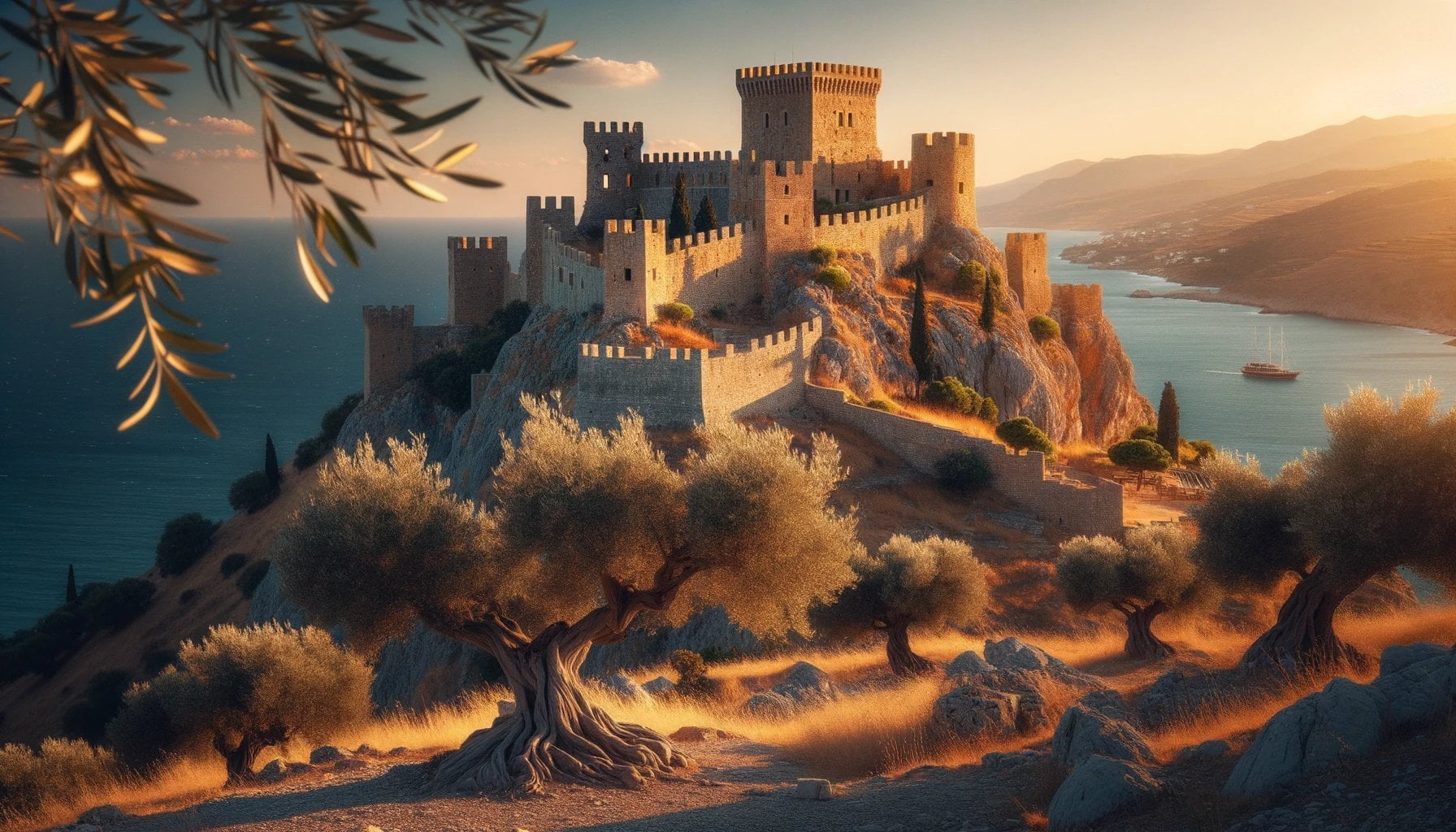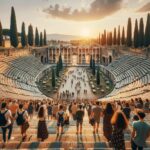Welcome to “Unveiling the Secrets: Exploring Ancient Greek Castles,” a captivating journey into the fascinating world of ancient Greek architecture. With a deep-rooted passion for unraveling the mysteries of the past, we delve into the captivating narratives and architectural marvels behind these magnificent structures. As we embark on this exploration, we will unearth the hidden stories and historical significance of ancient Greek castles, connecting the dots between past civilizations and our present world. Join us as we unlock the secrets and embark on an awe-inspiring adventure through the realm of ancient Greek castles.

Key Takeaways:
– Ancient Greek castles showcase the country’s glorious past and hold historical and architectural significance.
– The Castle of Rhodes, Castle of Astypalea, Castle of Nafpaktos, Castle of Ioannina, Castle of Kalamata, Castle of Molyvos, Castle of Nafplio, and Castle of Skyros are among the notable castles in Greece.
– Chlemoutsi Castle and the Palace of the Grand Master in Rhodes are considered the best castles in Greece.
– Athens Castle was captured by the Turks in 1462 and was later used as military barracks.
– Other relevant ruins in Greece include St George’s Castle, King Nestor’s Palace, and Karababa Castle.
– The Castle of Kalamata is situated on a rocky hill on the north-west side of the city.
– Sources for further information on ancient Greek castles include Historic European Castles, Greek Reporter, and Tripadvisor.
Ancient Greek Castles
Ancient Greek castles stand as majestic testaments to the country’s rich history and architectural prowess. These remarkable structures not only served as defensive fortresses but also reflected the cultural, political, and social aspects of ancient Greece. Join me on a captivating journey as we unveil the secrets and explore the wonders of ancient Greek castles.
A Glimpse into Ancient Greek Castles
Imagine standing amidst the ruins of an ancient fortress, surrounded by towering walls that have witnessed countless battles and dynasties. Ancient Greek castles offer a truly immersive experience, allowing us to step back in time and marvel at the ingenuity of the past.
As we delve deeper into the realm of ancient Greek castles, we come across fascinating elements that set them apart from other architectural wonders. From the enchanting Ancient Greek Gardens to the meticulously crafted Ancient Greek Courtyards, every aspect of these castles tells a story of its own. The landscapes they were built upon, the interiors adorned with magnificent paintings, and the structural designs that withstood the test of time all contribute to their mesmerizing allure.
Uncovering Greece’s Glorious Past
To truly appreciate the grandeur of ancient Greek castles, we must visit the splendid examples that have survived throughout the ages. Among these remarkable structures, the Castle of Rhodes reigns supreme, once serving as the seat of the Knights of the Order of St. John. Another gem is the Castle of Astypalea, perched atop a steep hill overlooking the Aegean Sea. And let’s not forget the Castle of Nafpaktos, a remarkable fortress guarding the entrance to the Corinthian Gulf.
Venturing further, we encounter the Castle of Ioannina, which never fails to leave visitors in awe with its blend of Byzantine and Ottoman influences. The Castle of Kalamata, meticulously perched on a rocky hill, offers breathtaking views of the surrounding city. Meanwhile, the Castle of Molyvos stands as a testament to the wealth and power of the Byzantine Empire.
Each of these castles tells a unique story, reflecting different periods and influences of ancient Greek history. The Castle of Nafplio, for instance, played a significant role in the War of Greek Independence. And on the picturesque island of Skyros, we find the Castle of Skyros, a stark reminder of the island’s turbulent past.
Beyond Castles: Exploring Ancient Greek Ruins
While ancient Greek castles take center stage, we mustn’t overlook the other fascinating ruins that dot the Greek landscape. St. George’s Castle, nestled on the island of Lesbos, offers a glimpse into the Byzantine era, while King Nestor’s Palace in Pylos immerses us in the grandeur of Mycenaean civilization. And let’s not forget Karababa Castle, which stands as a vital historical monument in Vidin, Bulgaria.
Drawing from diverse sources such as Wikipedia, Historic European Castles, Greek Reporter, and Tripadvisor, we can piece together the intricate puzzle of ancient Greek castles. By combining historical records, archaeological evidence, and our own expertise, we can paint a vivid picture of the past and connect ancient civilizations to our present world.
Conclusion
In our quest to explore ancient Greek castles, we have uncovered a wealth of knowledge and stepped into the shoes of the past. From the grandeur of the Castle of Rhodes to the captivating ruins of King Nestor’s Palace, each castle holds its own unique charm and historical significance. Through rigorous research and a deep understanding of ancient Greek history, we can unravel the secrets and share the captivating narratives of these architectural marvels. Let us embark on this journey together, as we connect with our roots and celebrate the splendor of ancient Greek castles.
The largest naval battle in ancient history is a fascinating event that will transport you back in time to witness the triumphs and struggles of ancient naval warfare.
Explore the intriguing palaces in ancient Egypt, where pharaohs and queens once lived in opulent luxury, and unravel the secrets of their majestic architecture.
Discover heartwarming and heartrending stories engraved on ancient dog epitaphs, offering a glimpse into the deep bond between humans and their loyal, four-legged companions throughout history.
Journey to an enchanting ancient city in Peru, where you’ll marvel at the architectural wonders left behind by the Inca civilization and unravel the mysteries of their sophisticated urban planning.
Unleash your inner warrior as you delve into the legendary tales and heroic feats of ancient Vietnamese warriors, who valiantly defended their land and traditions against invaders.
Immerse yourself in the captivating stories surrounding powerful and influential ancient Egyptian queen names, and gain insight into the significant roles these women played in shaping Egyptian history.
Unearth the forgotten names and stories of valiant warriors from ancient Syria, whose bravery and skill in battle left an indelible mark on the region’s history.
Embark on a journey through time and discover the intriguing lives and legacies of ancient queens from various civilizations, whose leadership and influence shaped the societies they ruled.
Uncover the remarkable ancient Persian inventions that revolutionized various aspects of human life, from technologically advanced hydraulic systems to intricate astronomical instruments. Explore the fascinating world of ancient Persian inventions.
Marvel at the achievements of the mighty ancient Romans, from their awe-inspiring architectural wonders such as the Colosseum, to their innovative governmental systems that shaped Western civilization.
Step into the past and visit majestic ancient castles in Africa, where tales of bravery and nobility echo through the centuries, providing a window into the rich and diverse history of the continent.
Uncover the secrets of an ancient Italian city, where ancient ruins and fascinating historical sites paint a vivid picture of the vibrant and influential civilization that once thrived there.
Architectural Features of Greek Castles
Ancient Greek castles are magnificent structures that reflect the rich history and architectural expertise of ancient Greece. These castles served as defensive fortresses, showcasing the cultural, political, and social aspects of the time. Let’s delve into the architectural features that make Greek castles awe-inspiring and captivating.
Architectural Influences and Styles
Greek castles exhibit architectural influences from various periods, including Byzantine, Venetian, Frankish, Ottoman, and more. These diverse influences are evident in the design elements and construction techniques employed. The combination of different architectural styles creates a unique and visually stunning castle landscape in Greece.
Trabeated Form
One distinctive feature of ancient Greek architecture is the trabeated or “post and lintel” form. Castles in Greece often follow this style, with upright beams supporting horizontal beams. This design creates a sense of strength and solidity, giving the castles a formidable appearance.
Defensive Elements
Greek castles were primarily built as defensive structures, and their architectural features reflect this purpose. Some common defensive elements include thick walls with battlements and embrasures, strategically placed towers for surveillance and defense, and narrow passages and fortified gates to control access. These features demonstrate the ingenuity of ancient Greek architects in designing structures to withstand attacks.
Strategic Location
The location of Greek castles is another significant architectural aspect. They are often situated on hilltops, cliffs, or islands to maximize their defensive capabilities and provide commanding views of the surrounding landscape. The strategic positioning of these castles showcases the meticulous planning and understanding of military tactics by ancient Greek architects.
Astounding Views
Architectural features of Greek castles are not only practical but also visually captivating. Many of these castles offer breathtaking views of the surrounding natural beauty, such as the sparkling Aegean Sea, lush greenery, or rugged mountains. The merging of natural and man-made elements creates a harmonious and awe-inspiring experience for visitors.
Key Takeaways:
- Greek castles showcase a combination of architectural influences, including Byzantine, Venetian, Frankish, and Ottoman styles.
- The trabeated form, characterized by upright beams supporting horizontal beams, is a prominent feature in Greek castles.
- Defensive elements such as thick walls, towers, and fortified gates reflect the primary purpose of these castles.
- Greek castles are strategically located on hilltops, cliffs, or islands to optimize defense and provide panoramic views.
- Visitors to Greek castles can enjoy stunning natural scenery, including views of the Aegean Sea and picturesque landscapes.
Sources:
- Culture Trip: The Most Beautiful Castles in Greece
- Historic European Castles: Best Castles in Greece
Excavation and Research Methods
Ancient Greek castles, with their rich history and architectural marvels, continue to captivate our imagination. But how do archaeologists unveil the secrets hidden within these magnificent structures? In this article, we will delve into the excavation and research methods utilized by experts to unravel the mysteries of ancient Greek castles.
The Surgical Aspect of Archaeology
Excavation lies at the heart of archaeological research, serving as the surgical procedure that uncovers and recovers buried material remains. It involves meticulously uncovering layers of history, recording findings, and piecing together the puzzle of the past. This delicate process allows us to gain valuable insights into ancient civilizations and their culture.
Current Theories and Practices
Classical archaeology, which focuses on investigating Mediterranean civilizations like Ancient Greece and Ancient Rome, relies heavily on excavation and research methods. The book “Classical Archaeology in Context” highlights the latest theories and practices in this field, presenting case studies derived from archaeological excavations in Greek cultural contexts.
Archaeologists employ a variety of tools and techniques to carefully excavate ancient Greek castles. These may include brushes, trowels, shovels, and even more advanced instruments like ground-penetrating radar or laser scanning technology. By meticulously documenting each find and its location within the site, researchers can reconstruct the ancient castle’s layout and understand its historical context.
Uncovering Ancient Artifacts
Ancient artifacts play a pivotal role in classical archaeology. These tangible remnants of the past provide vital clues about the lives and beliefs of ancient civilizations. Excavations in sites such as Troy, where the famous archaeologist Heinrich Schliemann made groundbreaking discoveries, have yielded remarkable artifacts that contribute to our understanding of ancient Greek castles and their inhabitants.
The Role of Excavation Programs and Schools
To ensure the preservation and exploration of ancient Greek castles, universities and foreign nations actively participate in excavation programs and schools in the region. For example, the University of Warwick conducts archaeological excavations in Policastro, an area settled by Greek colonists that showcases ruins from Greek, Roman, and medieval times. These programs bring together experts from various disciplines, fostering collaboration and advancing our knowledge of ancient Greek castles.
Connecting Past and Present
Archaeological excavations not only provide us with valuable historical information but also establish a connection between past civilizations and our modern world. The Acropolis Museum in Athens, for instance, incorporates an ancient Athenian neighborhood within its architecture to showcase archaeological excavation findings. This immersive experience allows visitors to step back in time and appreciate the ingenuity of ancient Greek castles firsthand.
Key Takeaways:
- Excavation is the surgical aspect of archaeology, uncovering buried material remains and providing insights into ancient civilizations.
- Classical archaeology relies on excavation and research methods to investigate Mediterranean civilizations, particularly Ancient Greece.
- Ancient artifacts are crucial in understanding the lives and beliefs of ancient Greek castle inhabitants.
- Excavation programs and schools run by universities and foreign nations contribute to the preservation and exploration of ancient Greek castles.
- Archaeological excavations establish a connection between past civilizations and the present, allowing us to appreciate the ingenuity of ancient Greek castles.
Sources:
– Haggis, Donald. Classical Archaeology in Context. De Gruyter, May 19, 2015.
– “Excavation.” Britannica. Retrieved from Link]
Implications of Ancient Greek Castles on Modern Architecture
The rich and awe-inspiring heritage of ancient Greek castles holds numerous implications for modern architecture. The lasting impact of Greek architecture on Western architecture and engineering cannot be understated. From the utilization of geometry and mathematical principles to the focus on precision and excellence of workmanship, ancient Greek architecture continues to shape the modern architectural landscape.
Uncovering the Secrets: Exploring Ancient Greek Castles
Excavating the Past
Archaeologists employ various tools and techniques, such as brushes, trowels, and ground-penetrating radar, to carefully excavate ancient Greek castles. Through excavation, buried artifacts are recovered, providing valuable insights into the lives and beliefs of the castle’s inhabitants. This method, coupled with research and analysis, allows for the reconstruction of past civilizations and the exploration of their architectural wonders.
Connecting Past and Present
Excavations serve as a bridge between ancient civilizations and the present, enabling us to appreciate the ingenuity and architectural marvels of ancient Greek castles. By delving into historical records and studying archaeological evidence, a vivid picture of the past is painted, showcasing the immense creativity and craftsmanship of ancient Greek architects.
Key Takeaways:
- Excavation is the primary method used to uncover and recover buried remains in ancient Greek castles, providing valuable insights into the lives of their inhabitants.
- Archaeological excavations establish a connection between past civilizations and the present, allowing us to appreciate the ingenuity and architectural wonders of ancient Greek castles.
Source: ResearchGate: The Enduring Legacy of Greek Architecture and Engineering: How Ancient

FAQ
Q1: What is the significance of ancient Greek castles?
A1: Ancient Greek castles hold historical significance and architectural marvels. They offer insights into ancient Greek history and showcase the precision and excellence of ancient Greek architecture.
Q2: What are some popular ancient Greek castles in Greece?
A2: Some popular ancient Greek castles in Greece include the Castle of Rhodes, Castle of Astypalea, Castle of Nafpaktos, Castle of Ioannina, Castle of Kalamata, Castle of Molyvos, Castle of Nafplio, and Castle of Skyros.
Q3: What architectural influences can be found in ancient Greek castles?
A3: Ancient Greek castles exhibit architectural influences from various periods, including Byzantine, Venetian, Frankish, Ottoman, and more.
Q4: Where can I find more information about ancient Greek architecture?
A4: You can find additional information about ancient Greek architecture on websites such as Wikipedia, the Metropolitan Museum of Art, Architectural Digest, and MasterClass.
Q5: How do archaeological excavations contribute to our understanding of ancient civilizations?
A5: Archaeological excavations provide valuable insights into the culture and history of ancient civilizations. They help uncover ancient artifacts and contribute to our understanding of how past civilizations lived.
- Unraveling Einstein’s Legacy: Who Inherited His Genius? - July 14, 2025
- Unlock Einstein’s Family Tree: Bernhard Caesar & Untold Stories - July 14, 2025
- Unveiling Bernhard Caesar Einstein: His Life & Albert Einstein’s Legacy - July 14, 2025
















